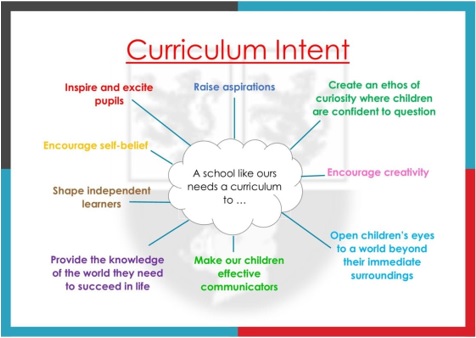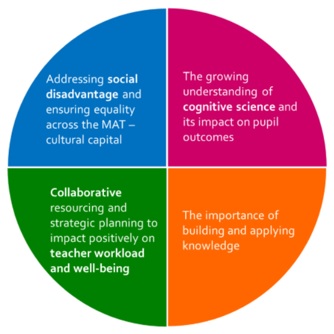A curriculum Inspector at Ofsted defines curriculum intent as 'Curriculum intent is all the planning that happens before a teacher delivers the knowledge to the students about the next thing they learn in the curriculum'.
Even though it’s nothing new, the hype around this topic continues to grow and schools are reported to be bombarded with offers for training and writing intent statements and policies. Essentially being clear about your curriculum intent ensures that you have a coherent, clear, and well-sequenced curriculum that is required for your children to grow. With all this in mind, here are a few things you need to know before your curriculum can be delivered.
What Is Curriculum Intent, Implementation And Impact?
Ofsted Inspection framework has derived the 3 'I's of education- Intent, Implementation, and Framework.
The intent is the 'what is taught in schools and why'. Implementation indicates the application of the framework within institutional content to help children thrive. Impact is the result of the knowledge imparted and what difference it can make.

Source: willington.durham.sch.uk
The term curriculum intent has been used a lot when talking about the engagement of the students. It is something that bridges the gap between disadvantaged people and higher-performing students as they develop their cognitive skills.
What Is The Ofsted Framework?
Ever since September 2019, Ofsted inspectors have been spending less time with the school leaders. They spend most of their time talking to teachers about curriculum intent, implementation, and impact. They are more interested to know what is going on within the classroom, hence teachers need to be confident and prepared.
The four inspection categories of Ofsted include:
- Personal Development
- Quality of education
- Attitudes and Behaviour
- Leadership and management
Hey, do you follow us on Social Media? We regularly share upgraded educational content, tips, feedback and more. Check us out by clicking the profiles here - Facebook / Twitter / LinkedIn / Pinterest / Instagram / YouTube
What Is Assessed Under The Quality Of Education?
Here is what the inspectors of Ofsted look for while grading the quality of education:
- In curriculum intent, the inspectors look for the curriculum aspirations the educational institutions have for their students.
- For the implementation process, they assess how the teaching staff carry out their chores to support the organization.
- Inspectors analyze the quality of presentation, assessment, subject knowledge, feedback, responsive teaching, and recall of material.
- To decide the impact, the inspectors assess whether or not the learners have developed the desired knowledge and skills across the taught curriculum and achieved fruitful results.
What Should A Curriculum Intent Include?
Ofsted has designed a very clear message for curriculum intent. The framework states that:
- The educational institutions need to have a broad and balanced curriculum
- The subjects must address a wide range of topics
- The curriculum must be well-sequenced and coherent with cultural capital, knowledge, and skills.
3 Steps To Define Your Curriculum Intent Properly

Source: scotchorchard.staffs.sch.UK
If you are willing to deliver a good curriculum, follow these 3 steps to develop a good intent:
1. Define The Purpose Of Your Curriculum
Strong educational principles define the best curricula and hence you need to secure the purpose of your curriculum. Before thinking about what to include in your curriculum, you need to think about the why. Start asking important questions like what you want your curriculum to achieve or what you want your children’s future to be like.
Do some deep thinking about your educational principles and use them as a guide to shape your curriculum. you will also need to consider the national requirements of your place, however, don’t be too tempted to follow any particular initiative or trend.
2. Develop A Student Offer
While setting your curriculum intent, you need to identify the broader learning experiences. Reflect on the purpose of your curriculum to make informed choices. You need to decide what experiences you want to include and how they can build over time. Include on-site and off-site experiences that you are willing to offer.
Be creative in sourcing experts from local businesses and make the most of what you have locally. See the bigger picture and don’t be afraid to take a chance to shake things up a little and do things differently.
3. Plan Your Curriculum Intent
The learning framework provided by the national curriculum does not offer enough structure and hence it is required to break down those programs into a clear progression framework. Since you need to develop a proper curriculum intent, you will need to have an essential structure. This will not only help you in your future planning but will also act as a roadmap for more detailed short-term planning.
Break down the framework into a series of knowledge and skills objectives, and show that you intend to cover the foundational concepts. Once you have created your plan, discuss it with others and ask for feedback. Also, ensure that you have systems to check how well your intended curriculum is developed.
Plan The Future Of Your Organization Effectively
The curriculum is first and foremost designed for the children. As per Ofstead, it is all about giving good advice and delivering noteworthy knowledge and skills. As a school leader, you can pursue offline or online courses in Early Years Care and Education to be aware of the inspection framework and stay updated. You can also sign up your faculty for this as they will be dealing with the inspectors and must have an idea about what a desired curriculum should be like.
We believe education should be accessible for everyone. That’s why we don’t charge for our blogs. Find the right course that will help you in your career with us, contact us at - 1800 - 212 - 6400. You can mail us at act@asiancollegeofteachers.com.
Written By : Sanjana








